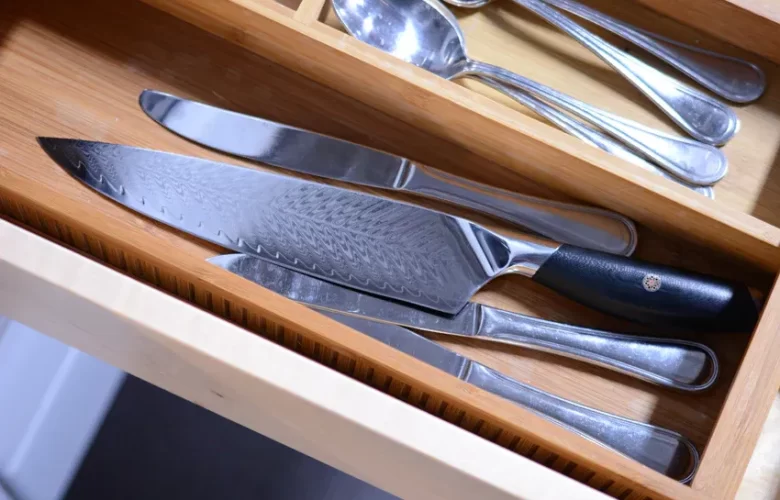Safety is especially important in all facets of life, including the kitchen. Dealing with sharp objects, particularly chef knives requires an extra level of caution. The kitchen can quickly turn from a joyful cooking haven into a hazardous environment with just one careless moment with a knife. High-quality chef knives are very sharp and can cause extensive injuries if misused or mishandled. Therefore, the proper handling, use, and storage of chef knives are necessary to maintain a safe kitchen environment.
The purpose of this article is to equip you with a complete guide to safely handle and store chef knives. Our content will cover a range of topics, starting with the variety and uses of chef knives, followed by a discussion of kitchen safety concerning these sharp tools. We’ll then provide you with advice on safely using, cleaning, and maintaining chef knives. As a bonus, we’ll examine safe storage alternatives and offer tips on teaching the younger ones about knife safety. By the end, you’ll have basic knowledge and tips to keep your kitchen a secure and comfortable space for everyone.
Table of Contents
An Overview of Chef Knives
Working with food on a significant scale started in ancient civilizations, evolving our culinary tools simultaneously. As human technology advanced, our tools followed. Bronze replaced stone, then iron, and eventually, steel became the dominant material. In the early 20th century, stainless steel knives were introduced and quickly became a favorite amongst chefs and home cooks due to their resistance to rust and discoloration.
There is a varied range of chef knives available today, each designed for specific tasks in the kitchen. The classic chef’s knife, often made of stainless steel, is known for its versatility. It’s suitable for virtually any task including slicing, dicing, and chopping a variety of ingredients. A paring knife, smaller than a chef’s knife, features a slim, pointed blade, and is perfect for precision tasks. Contrastingly, the bread knife, with its serrated blade, is designed to slice through crusty loaves without compression. Be sure to choose a knife that feels comfortable in your hand and suits your cooking style.
Safe Handling of Chef Knives
Holding a chef knife correctly ensures stability and control. Your thumb and index finger should grip the blade’s top, with your other fingers wrapped around the handle. Pay attention to the firmness of the food item while cutting. Harder foods, such as root vegetables, should be cut slowly and carefully to prevent the knife from slipping. For softer or more slippery foods like tomatoes or meats, using a serrated knife could offer better control. Always curl your fingers inward to protect them from accidental cuts.
When passing a knife, the safest way is to set it down on a secure surface and let the other person pick it up. If you must hand it directly, always offer the handle and not the blade. Never use a chef knife for anything other than its intended purpose. Do not leave a knife on the edge of a countertop or attempt to catch a falling knife. Good habits and a bit of patience will reduce accidents when using chef knives.
Proper Cleaning and Maintenance of Chef Knives
Keep your knives clean and sharp to maintain their efficiency and longevity, besides ensuring safety. A clean, sharp knife is less likely to slip and cause injury. Start by gently cleaning the blade with a soft cloth or sponge soaked in mild soapy water. Hand wash knives and immediately dry them to prevent rust or staining.
Regular sharpening ensures your knife performs optimally. A honing steel can keep the knife edge straight and aligned. Boning knives require professional sharpening due to their thin, flexible blades. Always store your knives in a safe, protected place, like a knife block or a magnetic knife strip, to increase their lifespan and ensure safety.
Safe Storage of Chef Knives
Improperly stored knives can get damaged, dull, or pose a safety risk. Suppose a sharp knife is carelessly stored in a drawer with other utensils. You might accidentally cut yourself when looking through the drawer. Besides, it can damage other items or chip the knife’s blade. Safe storage methods like knife blocks, magnetic wall strips, knife rolls, and in-drawer knife holders can prevent these risks.
Training Kids on Knife Safety
The right age to introduce knife safety to children can be tricky as it largely depends on the child’s maturity and interest in learning to cook. Generally, basic knife safety can be introduced around age 5 or 6, with safe, kid-friendly knives and supervision. With increasing age and confidence, proper chef knives can be introduced around age 10 or 12. Begin with simple tasks like spreading butter or slicing soft fruits with a butter knife. As their skills mature, they can take on more complex tasks. The key is clear instruction and supervision.
Abiding by and practicing these guidelines is not only about ensuring a safe kitchen but also about using your culinary tools more effectively. Bear in mind, a well-maintained and safely stored knife is key to a secure and efficient kitchen. Cultivating respectful, learned behavior with chef knives can make cooking more fun for everyone involved. Wishing you safe and happy cooking!

